You must be logged in to rate content!
14 minute read
Dual Oil Catch Cans 370Z
Compliments of sixpax @ www.the370z.com
3-21-2012
Disclaimer: This is primarily for the extreme novice, like me, so hard core types will find this simple and rather boring. I spent alot of time researching this, so am only trying to help others with similar skill set as mine save time in the future. There are several good threads about catch cans, but none that were specifically dual cans on an NA motor with the stock intake manifold.
This is a photo showing all the parts I ordered to do this.
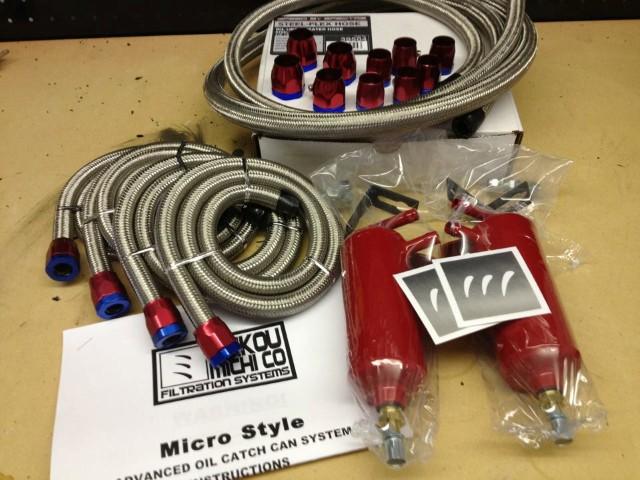
Why bother doing this ?
The 370Z has dual intake inlets that suck in blow by gases from the PCV valves. One for each side of the motor (annotated diagram below). These blow by gases can create damaging carbon and oil sludge build-up in your intake, including your intercooler for you FI guys. Even NA motors (like me) can benefit from using catch cans. I have read that NA guys trap just as much oil as FI guys, so not a bad idea for either platform. Less oil in your intake also reduces the risk of detonation. This is primarily due to less degradation of the octane rating of the gasoline you are using while it burns away. In theory, this would enhance performance. Improved reliability and health of the engine for increased longevity. I could find no cons to doing it, besides creating another routine maintenance chore and cost.
Props to wstar for some great information about how the entire PCV system works in his DIY-Oil Catch Can thread, and also for taking the time to answer some PMs from me while I was researching this. 
There is another thread that talks to the advantages of catch cans along with some more PCV insight.
Why two cans instead of one ?
Being a retired military dude, I learned to never "half azz" anything. Either go big, or GTFO. Mainly I chose two because the motor has two separate closed breathing routes ... one on each side of the motor. You could combine those lines, and run one can, but I felt more comfortable letting it breathe the way it was intended. Also consider that the smallest opening in the system is what limits the flow of gasses to the can, which is why I stopped considering one can by using a T connection ... the T connection becomes a minor restriction as well as reducing two hoses into one. Also make sure the fittings on the can(s) are matched to your hoses. Plus, I am anal about things being "uniform" ... so if I do something on the right hand side of the engine bay, by golly we have to do the same thing on the other side to kind of balance things out and make it look pretty. I am also lazy by nature, so I figure I will have to check them and empty them two times less often as compared to one can twice as much. It is an added maintenance chore, but well worth the benefits.
Why Saikou Michi ?
Many catch cans on the market today are just empty cans with an inlet and an outlet. If you are going to use one of those types, you might as well empty out a coffee can, spray paint it black and hook up some NPT nipples to it and you are good to go. While they do trap some oil, they are not really as effective as a truly baffled can. The air entering the can is escaping fast and returning to the intake manifold, though heat and condensation do allow them to catch some oil. The cans I chose are truly baffled. On top of being baffled, they are also "micro" filtered ... so twice the opportunity to eliminate the oily nasties before they exit the can. I noticed a few GTR guys using these, along with many Lotus and Corvette owners. I figured if they are good enough for those rides, they are good enough for me. They are also made in the U.S.A., are priced at nearly the same price point as many of the empty do nothing can's out there, and are 100% custom made how ever you want it. This includes color, orientation of the inlet and outlet, how big it is, any custom bracket you want to mount them with and some pretty cool looking decals. I basically had to fill out a nifty configurator worksheet that they then used to manufacture the cans. There are other baffled choices out there, but I liked dealing with these guys ... they operate in a very personal, hands-on customer oriented way. The packaging and quality of the cans was top notch. Lead time from order placed to product shipped was about 2 weeks. I chose the Micro Style OCC, mainly to use up less space and they are super light. Saikou Michi also uses a "thin wall technology" they use to manufacture the cans, which results in a super lightweight end product. I have included a link to the cans below in the parts list.
What are all the parts shown in your picture and where do they go ?
At the same time I am installing the catch cans, I am replacing all the crankcase breather hosing with stainless steel. Therefore, this could obviously be done for a lot cheaper using either silicone, or some other rubber hosing. I opted for the bling affect that SS lines give me. 
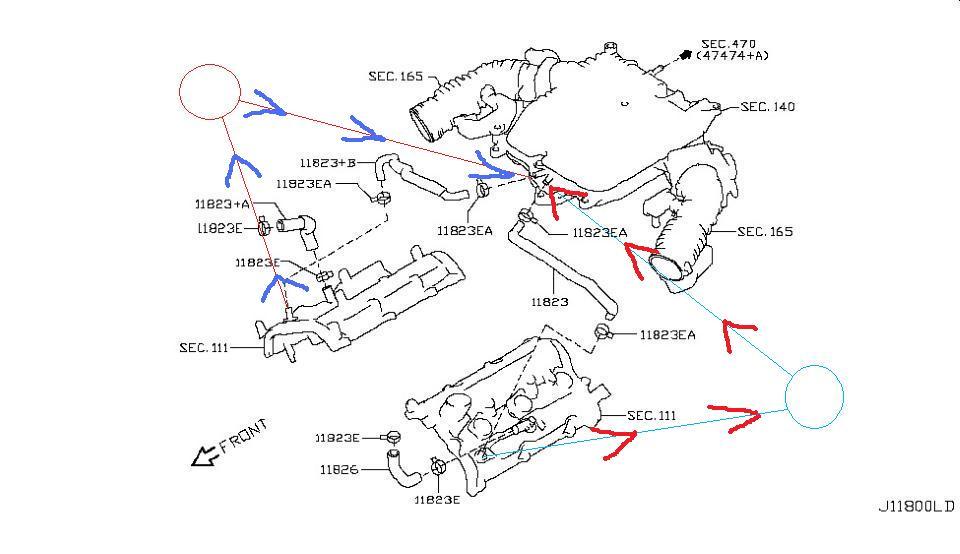
In the diagram above I used my mad paint skills to add a red circle on the left, and a blue circle on the right. These represent the left, and right oil catch cans. So for the right, or blue circle ... hose 11823 enters the right side "V" at the intake manifold ... this will come from the outlet of the blue can. You will enter the input of the blue can with another line, from where hose 11823 currently exits the motor.
For the red circle side, same thing, only the hose is 11823+B. From the left intake manifold "V" to the outlet of the catch can, out of the catch can to the nipple where hose 11823+B currently terminates.
These connections are all 3/8" ID at the intake manifold and where they return to the motor. I ordered my catch cans with the same size NPT nipples, so that makes a total of eight (8) 3/8" ID connection points.
As such, I ordered four (4) 3' lengths of hose with eight (8) 3/8" clamps. You actually get two clamps with each 3' hose so it worked out a little better to get the 3' sections as opposed to 2' bare sections and then buying the clamps separately. Better to have too much hose, than not enough, so I plan on trimming it down all pretty once everything is in place where I want it.
Now, as I mentioned, I am replacing the other breathing hose as well. These have nothing to do with the catch cans, but in case you want to change them out I am including what I did. These are hoses 11826 on the right, and 11823+A on the left. These both go between the motor and to either your stock intake boxes, or to your CAI. In my case I have a Typhoon, so these go from the motor to the underside of my CAI. They are 1/2" ID at both connections. So, I ordered a 4' (was the shortest I could get in half inch) hose section and four (4) 1/2" clamps. I will trim it up to do both sides. This stuff is supposedly easy to cut, tho I have not actually cut any yet. It's rated up to heater hose, so maybe I can use the left over to do something else.
I ordered all of the hose and clamps from Spectre Performance directly. I liked the AN style connectors that are just AN look alikes with a worm gear clamp built inside of them. Because of the plastic nipples on the intake manifold, there was really no way to go with a true AN style connection, and that would have been much more expensive anyway.
Complete Part List
(2) Micro Style OCC with 3/8" NPT fittings from Saikou Michi
(4) Spectre SS 3/8 ID 3' Hose 29490
(8) Spectre SS 3/8 ID Clamps (comes with part number 29490)
(1) Spectre ½ ID SS Hose 4' 39504
(4) Spectre SS ½ ID Clamps 3160
...now I will move onto mounting location considerations, and start planning the line runs.
Mounting Location
In order to be uniform, I wanted to mount both sides in the same location. When I removed the stock air boxes and put the Typhoon's on, I had pretty much settled on the fact I was going to use the ear tabs that were now vacant as the mounting location for my catch cans. One concern I had with this mounting location was interfering with the air flow to the Typhoon, but once fitted the can is not blocking the air coming into the bay from the fang vents. I don't feel it is disturbing normal air flow enough to worry about. The two mounting locations are shown below.
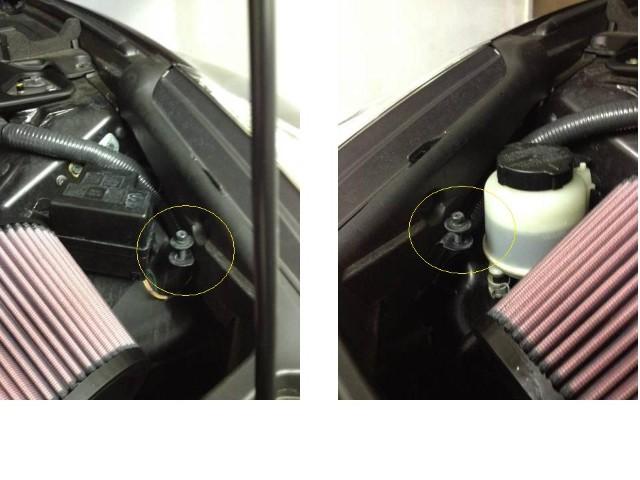
I went to Home Depot and got a couple 3/4" aluminum spacers, and used the stock bolt that used to hold the air box on the ear tab. The spacer gave it just enough lift that made clearance all around perfecto. I test mounted one can (below is the driver side) to make sure clearance was good, and also that it would not interfere with the hood closing.
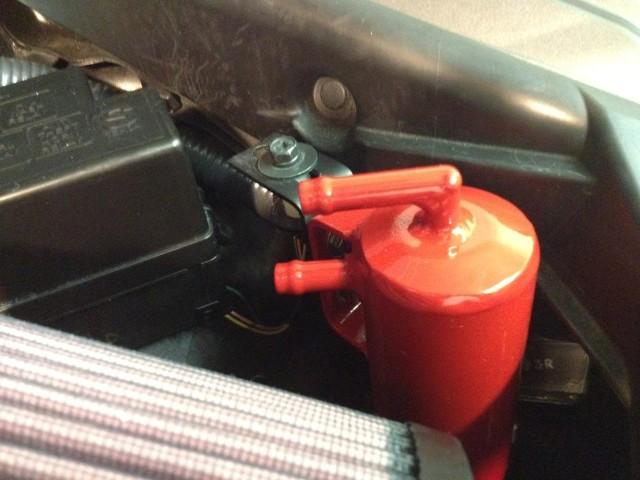
Trimming the Lines
According to the packaging, using electrical tape you bind where you want to make the cut. Then use a fine hacksaw blade. I opted to whip the Dremel out with a metal cutting wheel to speed things up. The tape keeps the SS braiding in place. Blow out the line with an air hose to remove any stray fibers. The tape stays in place, and is covered and hidden when you slide the clamps on.
I did discover that cutting the lines as recommended, with a fine tooth hacksaw blade, sucked. It creates to many stray fibers, takes forever, and the cut I ended up with was raggedy looking. I had much better luck using a metal cutting wheel with my Dremel. Tape the cut area tightly with some good quality black electrical tape. The tape will stay behind after cutting to keep the SS sheath in place, and is covered up by the Magna Clamps. The resulting cut was nice and neat and the cutting was much faster, so I ended up using that method to cut all the lines. It does create some mess inside the tubing when the cut is done, so I had to make sure I blew out the residue and had nice clean tubing.
Line Runs
I decided on 26" lengths for my can outlets (clean air back to the intake) and 18" lengths to feed the cans from the PCV valves. With these lengths, I actually could have ordered one less 3' section. The two 18" runs can be accomplished by cutting a 3' section in half. 
At first I had them laid out to go under the intake, but bailed on that due to the fact the hoses exiting the valve cover were getting kinked a little too much to my liking. After settling on a route going over the intakes, I actually liked it better cosmetically as well. The nipples coming out of the intake manifold are actually offset (up and down) more than I thought. This throws off the lengths being equal on both sides a little bit. If I had it to do over again though, the passenger side can outlet hose would have been 27", and the driver side can outlet hose 25".
Another advantage I accidentally stumbled on by ending up with the routing I chose is that it will make it easier to empty the cans. Just remove the mounting bolt, and there is enough play in the lines to raise the can upward to get access to the drain plug and empty. No need to unhook any of the hose connections, which for a lazy guy like me ended up working out great. If I had routed the hoses under the intakes, as originally planned, that would not be possible.
For some reason, the valve cover outlet nipple on the passenger side seemed a little bigger than the opposite side. I got the driver side on fairly easy, it was some muscle power to get the passenger side hose to go on.
...all done with the catch can connections. Need to finish up my 3/8" connections, but no need to post that progress in this thread. These are the hoses (11823 and 11823+B in the diagram above) that are eliminated, essentially replaced by four (4) hoses.
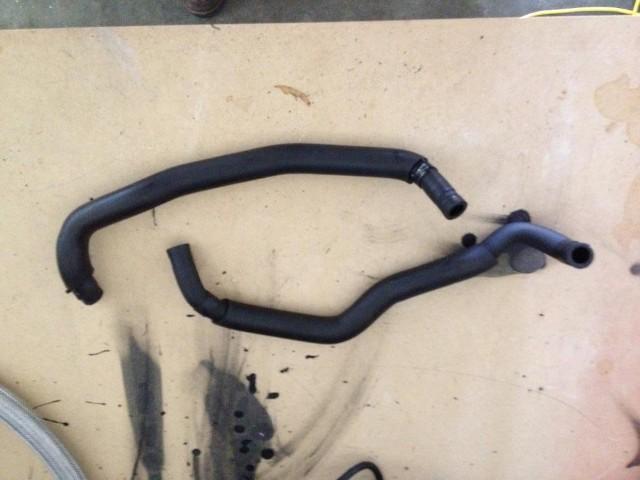
Couple shots of the finished can set-up. I had previously used a Dremel to cut down my engine cover. The SS hoses are a little thicker than the stock hoses, and they lack the custom bends to be short and fit nice. So there was no way the cover was going to seat all the way down.
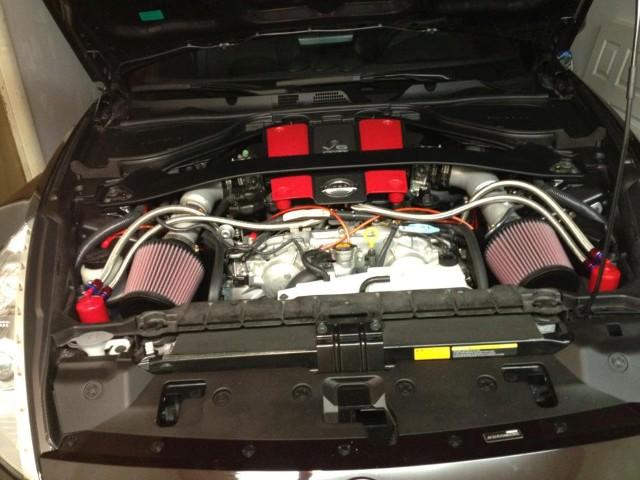
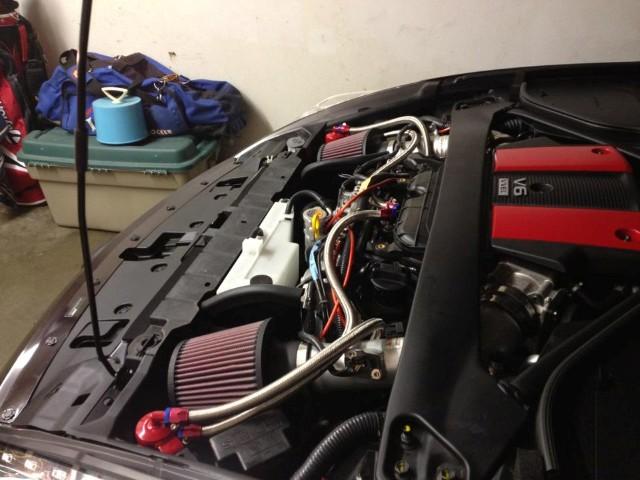
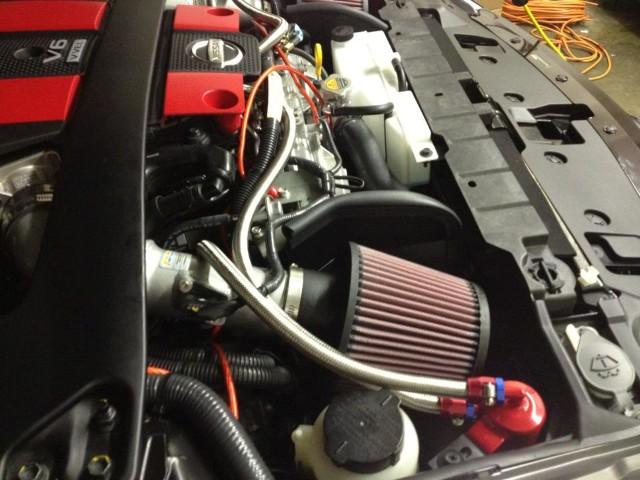
...and of course had to put my Saikou Michi decals on them for added powah, though I wish they were white instead of chrome 
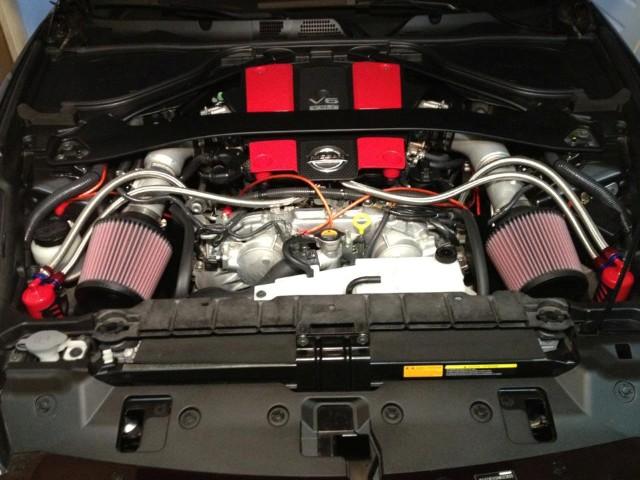
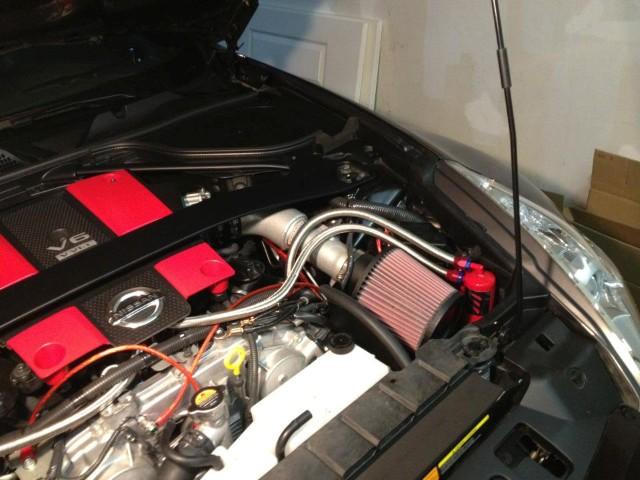
6-23-2012
... back in March at roughly 7,035 miles I had installed this dual oil can catch set up ... today at 7,915 miles I decided to empty both of the cans just to see how much was in there. Was more than I expected, but more unexpected was the fact that the driver side can probably accounted for about 70% of what is in the bag ... 30% from the passenger side can. Weird, I would have thought they would be somewhat even.
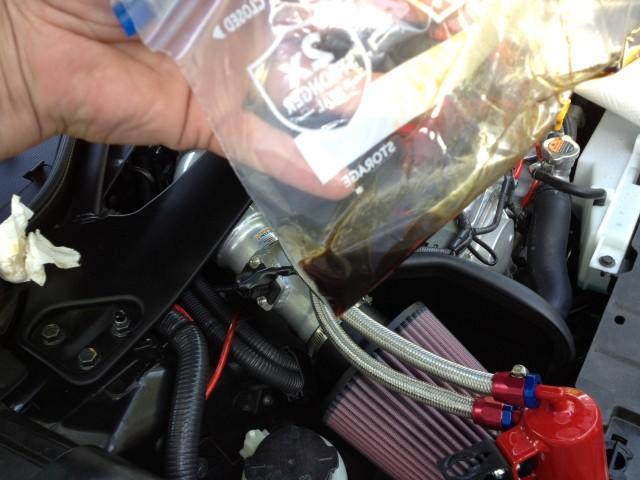
Great details!
Posted by Diggymart on 10/2/19 @ 1:20:44 PM